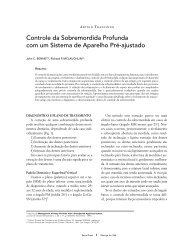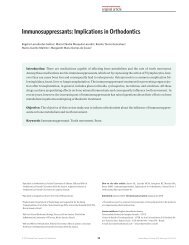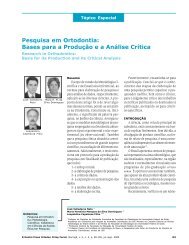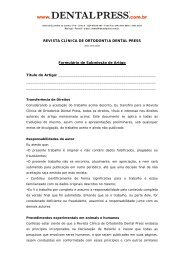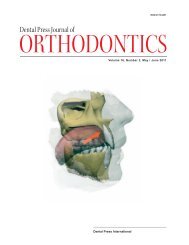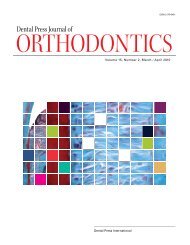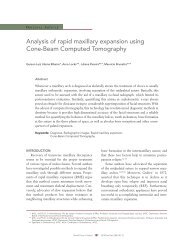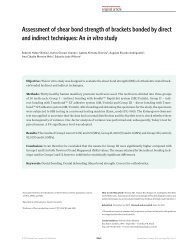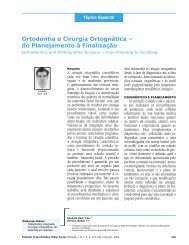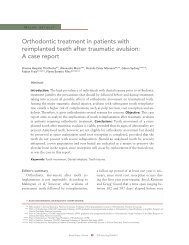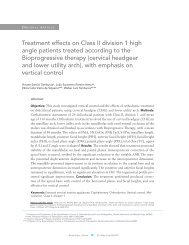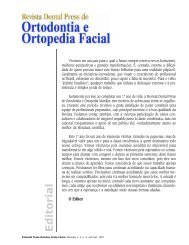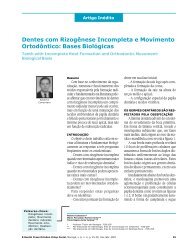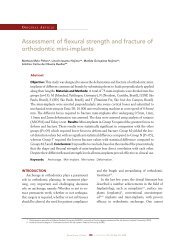Dental Press
Dental Press
Dental Press
You also want an ePaper? Increase the reach of your titles
YUMPU automatically turns print PDFs into web optimized ePapers that Google loves.
Weckwerth PH, Siquinelli NB, Weckwerth ACVB, Vivan RR, Duarte MAHIntroductionThe Enterococcus genus includes members previouslyclassified as Group D Streptococci due to thepresence of Group D cell wall antigen, a glycerolteichoic acid associated with the cytoplasmic membrane.Enterococci are normal inhabitants of the gastrointestinaltract and are found in lesser amounts inthe vagina and male urethra. 1These have become important pathogenic microorganismsin humans, mainly due to their resistanceto antimicrobial agents and to recently studied virulencefactors. 2These Gram-positive cocci are arranged as pairs orin small chains, and are very hard to differentiate fromstreptococci. They are facultative anaerobes that thriveat 35 o C, typically growing on the surface of blood agarplates as gamma-hemolytic cultures and on M-Enterococcusagar medium as deep-red or purplish colonies.Enterococci are tolerant to bile at 40% and can hydrolyzeesculin. Moreover, they are able to grow in thepresence of 6.5% sodium chloride, and can be distinguishedfrom bacteria in genus Staphylococcus by theirinability to produce catalase. 3Enterococcus faecalis are frequently found in root canalsafter failed endodontic therapy. 4,5,6Being highly resistant to several medications, theyare also among the few microorganisms that displayin vitro resistance to calcium hydroxide. This resistanceis related to a proton pump 7 or to biofilm formation.8 In an attempt to overcome this resistance,the addition of different substances to calcium hydroxidehas been proposed.One of the additives suggested is chlorhexidine, abiguanide. Calcium hydroxide-chlorhexidine paste hasshown better antimicrobial action in vitro, comparedwith calcium hydroxide paste with pure water. 9 Despiteits positive antimicrobial effect, this associationhas shown greater peroxide ion release, resulting ingreater tissue irritation. 10New alternatives have been proposed in endodontictherapy, including natural substances such as propolisand phytotherapeutic agents. One of these phytotherapeuticagents is Casearia sylvestris Sw infusion oralcoholic extract.This plant is native to Latin America, from Mexico toArgentina. It is found throughout Brazil, being particularlycommon in the state of São Paulo. It is popularlyknown as guaçatonga, erva de lagarto (“lizard’s herb”),vassitonga, bugre branco, among other names. Theword “guaçatonga” originated from the Tupi-Guarani(indigenous language), showing that this species wasknown by the native populations of Brazil. 11Guaçatonga extract has shown antiinflamatory 13and antimicrobial action. 14 However, no studies showingwhether the addition of phytotherapeutic agents tocalcium hydroxide paste interferes with its antimicrobialaction can be found in the scientific literature.With this in mind, the objective of the presentstudy was to evaluate the sensitivity of several Enterococcusfaecalis strains isolated from the oral cavityto direct contact with calcium hydroxide pastes associatedwith Casearia sylvestris Sw (guaçatonga) in propyleneglycol, calcium hydroxide with pure propyleneglycol, or calcium hydroxide and 1% chlorhexidine inpropylene glycol.MetodologyPreparation of the extractThe Casearia sylvestris Sw leaves used in this studywere collected at the Lageado farm, School of AgronomicalSciences - Unesp, in Botucatu, state of SãoPaulo, and identified at the herbarium of the SagradoCoração University (USC) - Bauru, São Paulo, Brazil.After harvesting and desiccation, the material wasfurther dehydrated in an air-circulating oven undercontrolled temperature until constant weight wasachieved. Following that, the leaves were trituratedin a knife mill and used to prepare the extract. Thedehydrated material was macerated in propylene glycol(extracting solution) following a ratio of 25 gramsof powder to 200 ml of extracting solution. The plantpowder remained in the extracting solution for eightdays, with sporadic agitation during that period. Theentire extraction process took place in an amber coloredcontainer (in order to prevent possible interferenceby light) and at room temperature (25ºC).Enterococccus StrainsForty E. faecalis strains from the USC Microbiologylaboratory bacterial library were used in the presentwork. These strains were cultured from bacterialsamples obtained from the oral cavity of patients seenat the USC School of Dentistry Endodontics clinic inBauru, Brazil.© 2011 <strong>Dental</strong> <strong>Press</strong> Endodontics 47<strong>Dental</strong> <strong>Press</strong> Endod. 2011 apr-june;1(1):46-51



